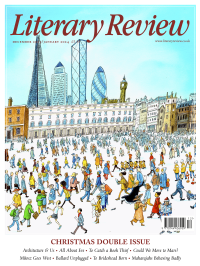William Whyte
Who’s Afraid of Flying Buttresses?
Architecture in Britain and Ireland, 1530–1830
By Steven Brindle
Yale University Press 582pp £60
First published exactly seventy years ago, Sir John Summerson’s Architecture in Britain, 1530–1830 has never been out of print. Compact and clearly written, it somehow managed to encompass a lifetime’s learning in some thirty short but lucid chapters. In a review of 1954, the distinguished architectural writer J M Richards predicted, ‘It will certainly remain the standard textbook for many years to come.’ Nine editions later, it is indeed still essential reading for anyone interested in the subject.
Summerson’s skill was twofold. In the first place, as Richards recognised in his review, he managed ‘to deploy masses of facts while producing a readable narrative’. Secondly, and just as importantly, he was not a neutral commentator. Summerson had views. He had trained as an architect and combined his work as curator of Sir John Soane’s Museum with a career as a proponent of modern architecture. He was also strongly influenced by the development of art history as a discipline. His narrative was an argument as well as a story.
Even the chronological limits of the text were ideological. Beginning with what he called ‘The English Renaissance’ and ending with the first glimmerings of the Gothic Revival, Summerson’s book was focused on the rise and development of classical architecture. His heroes were the architects who imbibed the principles laid

Sign Up to our newsletter
Receive free articles, highlights from the archive, news, details of prizes, and much more.@Lit_Review
Follow Literary Review on Twitter
Twitter Feed
Princess Diana was adored and scorned, idolised, canonised and chastised.
Why, asks @NshShulman, was everyone mad about Diana?
Find out in the May issue of Literary Review, out now.
Literary Review - For People Who Devour Books
In the Current Issue: Nicola Shulman on Princess Diana * Sophie Oliver on Gertrude Stein * Costica Bradatan on P...
literaryreview.co.uk
Under its longest-serving editor, Graydon Carter, Vanity Fair was that rare thing – a New York society magazine that published serious journalism.
@PeterPeteryork looks at what Carter got right.
Peter York - Deluxe Editions
Peter York: Deluxe Editions - When the Going Was Good: An Editor’s Adventures During the Last Golden Age of Magazines by Graydon Carter
literaryreview.co.uk
Henry James returned to America in 1904 with three objectives: to see his brother William, to deliver a series of lectures on Balzac, and to gather material for a pair of books about modern America.
Peter Rose follows James out west.
Peter Rose - The Restless Analyst
Peter Rose: The Restless Analyst - Henry James Comes Home: Rediscovering America in the Gilded Age by Peter Brooks...
literaryreview.co.uk